So far I feel that I have bars, bumpers, and racks pretty well covered on this site. I’m certain you can find something useful on this site if you’re shopping for one of those core garage gym pieces. What I haven’t covered very well to date are change plates. Since it’s likely that just about every lifter will ultimately find themselves in the market for change plates in some form, I felt that it was about time to give them a little attention.
Last updated January 2018 – minor revisions and price checking.
Difference between change plates and fractional plates
Change plate collections can vary slightly, but they are typically the six pairs of metric plates that include 0.5 kg, 1 kg, 1.5 kg, 2 kg, 2.5 kg, and 5 kg plates; or the three pairs of Imperial plates including 2.5 lbs, 5 lbs, and 10 lbs. When thinking in terms of bumper plates, one can usually associate any disc smaller than 450 mm in diameter as a change plate, but this line of thinking doesn’t work with steel or rubber-coated discs since all plates below 20 kg (or 45 lbs) is of a smaller [than 450 mm] diameter.
Fractional plates are still change plates, but are different in that they weigh “fractions” of a unit; either kilograms or pounds, of course. So while the change plate set would consist of pairs of 2½-lb, 5-lb, and 10-lb discs, a fractional set in pounds would consist of a pair of ¼-lb, ½-lb, ¾-lb, and 1-lb discs.
Fractional plates do allow for much smaller increases in load, but it is my opinion that most people can make the jumps in weight that normal change plates would allow for and don’t need to micro-load with fractional plates, especially with those who lift in kilograms. Though needless to say, that’s up to you to decide.
Friction plates is another term you’ll hear floating around. Friction plates are exactly what they sound like, plates that hold on to the bar by friction; no collars needed. Most rubber plates out there are not friction plates, but they still do a pretty good job of holding on to the bar without the use of collars. Both the Rogue and Vulcan change plates I’ll be talking about work very well without collars even though they are not “actual” friction plates. If you want a real friction plate set, Rogue offers them (plate sizes 0.5 kg through 2 kg.)
Do you need change plates?
Probably. If you are new enough to lifting, you can usually get away without having change plates for a while since bigger jumps in weight are more common as a total beginner, but ultimately you’ll need them. If you work out with pounds rather than kilos, there’s only three change plate pairs to get so you can gear up for very little cash. On the other hand, if you work out in kilograms, expect to spend quite a bit for a full set since there is no less than six pairs of kilogram change plates; more if you include any of the fractional plates.
Technically you can save a lot of cash by buying cast iron change plates. This is especially true if you work out in pounds, as you can run to the box-store and pick up 2½’s and 5’s for practically nothing. However, you should know though that cast iron plates will destroy the finish of the sleeves on your bar. Any lift ending in an impact with the floor (deadlifts, barbell rows, snatch, clean & jerk, power clean, etc) sends those metal plates bouncing and rattling on the bar, and you end up with gashes, nicks, and lost chrome/zinc. I suggest using steel plates only for controlled, slow lifts like bench press, overhead press, etc.
Vulcan Strength Rubber V-Lock Change Plates
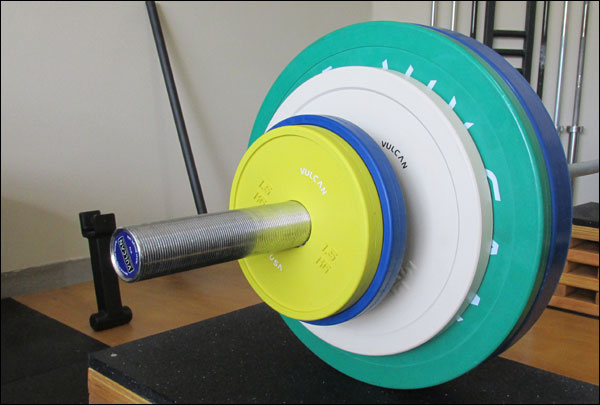
So I’m going to just start with my top pick rather than try to build up a bunch of anticipation by listing them in a special order like bad – good – better; or something like that. If for some reason you don’t like these then by all means read on. Otherwise take a quick glance at the others just to be sure and then go read another article – preferably on this site!
So why are these my favorite? There are a few things that I expect from my change plates: accuracy in claimed weight, durability, and affordability. Additionally, I don’t want to have to be concerned about bar damage, and I’d like for them to stay on the sleeve without having to be collared on. Less important is the IWF-color scheme, and a lack of noise.
The Vulcan V-Locks are not the only change plates available that offer all of these qualities, but of those that do they are the most reasonably priced. Yeah V-Locks are more expensive than painted steel change plates like the Strength Shop plates I’ll cover below, but they are still affordable. About $25 less than Rogue’s kilogram set, and about $50 less than Eleiko’s.
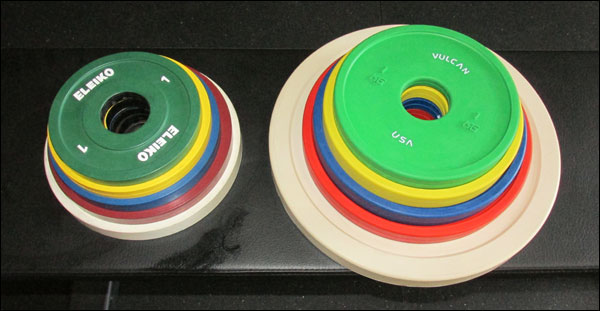
Eleiko and Vulcan both offer accuracy and durability without potential bar damage. The Eleiko plates are very nice looking and definitely accurate, however, they will set you back over $300 after shipping versus $239 shipped from Vulcan.
V-Locks are not just rubber coated; they are completely rubber. There is no steel anywhere, and this is why they are of a larger diameter than the other brands that contain steel cores. They offer all the benefits of rubber-coated steel discs (like the Rogue and Eleiko plates), but then there is the added benefit of there being no risk of exposing metal over time, which generally happens inside the hole; which of course will start to wear down the sleeve finish.
While not technically friction plates, the V-Locks do function in a similar manner. Since there is no steel insert or other smooth material wrapped around the diameter of the hole, they do an excellent job of staying put on the bar outside the collars. I still personally stick the 5 kg disc inside the collars, but that’s only because it’s such a large plate. Each V-Lock also fits well inside the recess of the next larger plate when on the bar rather than just sitting next to each other as it is with the other brands.
All-in-all, these are the best bang for the buck. If all my change plates disappeared tonight, I’d order the V-Locks again to replace them. They aren’t as expensive or fancy looking as the Eleikos, but they aren’t actually as expensive as the Eleikos either. Now it does just so happen that they just as accurate as the Eleikos though.

Vulcan V-Lock Change Plate weigh-in. These are well within stated tolerances. Actually they are all within 5 grams which is pretty damn accurate. Click to enlarge.
The entire V-Lock set is $239, ships for free, and is warranted for 5-years. That’s anywhere from 2 to 5 years longer than the rest of them. Solid option? The best option!
Rep Fitness Kilogram Change Plates
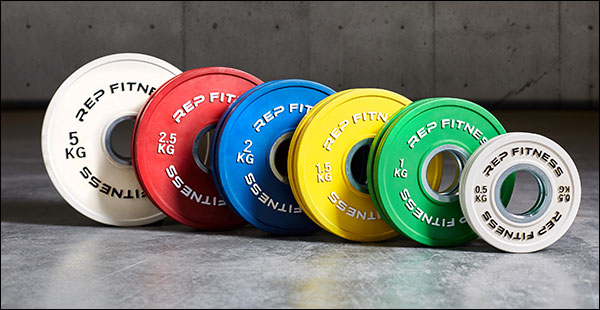
Rep previously sold the same plates as the above Vulcan V-Locks but stopped selling them what seems like two years ago now. They recently replaced them with a model that is more similar to the Rogue change plates (that I’ll discuss below) than the V-Locks, only they have a steel insert rather than being completely coated in rubber.
The new Rep Fitness Kilo Change Plates follow the same IWF color scheme as all proper change plates, and the size of each plate is pretty much in line with the normal IWF plates. That is to say, they aren’t slightly over-sized like the V-Locks.
What makes the Rep change plates different from the rest is the use of a steel insert rather than being rubber. This does make them less likely to stay put outside of your collars since there isn’t much in the way of friction between the plates and the bar, but it does allow for a less expensive option to all the other rubber-coated change plates.
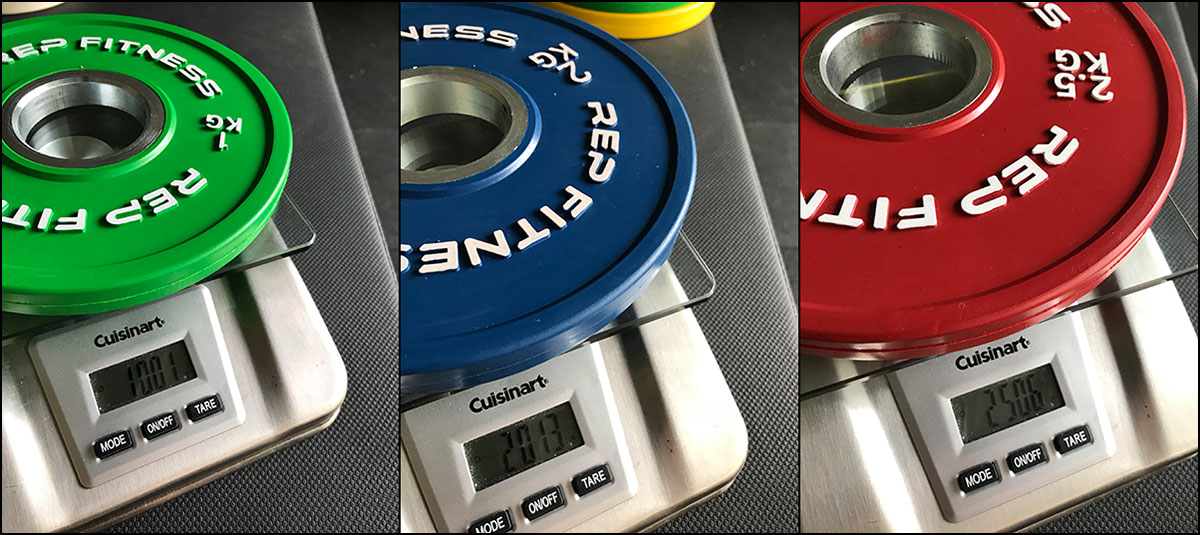
Not as accurate as IWF-certified plates or even the V-Locks, but for the money they are very accurate indeed.
At only $169 for the full 25 kg set of Rep Change Plates, the price is very, very competitive. It’s possible that with shipping they may even be cheaper to your door than the purely iron Strength Shop USA plates discussed below – my least favorite option of them all. Now Rep doesn’t promise accuracy to within 10 grams, but my weighing of all 12 of the plates proved to me that accuracy is still within 1%. Heck better than that even, but since they don’t make any claims to accuracy I’m reluctant to tell you any better than that 1%.
For non-sanctioned use (aka a garage gym), I think this may be the best deal around. Feel free to pay for more change plates with a rubber insert, but know that if you simply need the weight and not the fanciest thing around, these are the way to.
Strength Shop USA Kilogram Change Plates
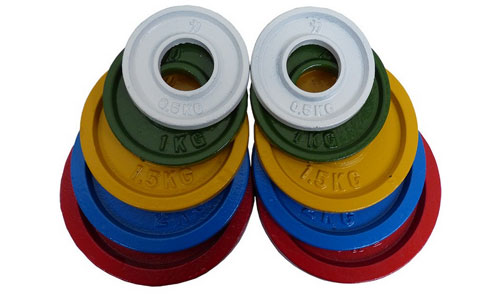
There is one thing I really like about the Strength Shop USA plates; the price. However, I do not like what they do my bar sleeve during lifts like the deadlift or power clean; lifts that end with the bar hitting the mats with any momentum. When that happens, these things bounce around on the sleeve, and more times than not, they take a piece of the bar’s finish off and replace it with colored paint from the plates.
The SS USA plates are nothing more than steel plates with a thin coating of colored paint. They look legitimate enough, but they have no protective rubber coating – not even around the circumference of the insert. The very first day that I used the 2.5 kilogram change plate for deadlifts, I ended up with paint in the grooves of the sleeves and two deep gouges that are there for good. That damage was done from dropping a bar only 1 or 2″ at the bottom of deadlifts. I never even got a chance to drop the thing from an overhead position.
These are very affordable when compared to the rubber-coated discs, no doubt about that. Still though, I can’t see these being useful to anyone who does anything but bench pressing and squats. That is, unless you’re lifting on a bar with bare steel sleeves, or a beater bar of some kind. Clean, snatch, deadlift, or barbell row with these plates and you will mar up your bar sleeves.
The Strength Shop change plates are the same basic design as the Pendlay change plates; for those who remember those beauties. All six pairs of colored steel change plates will cost you $150 before shipping. That’s the 5-pair set (0.5 kg, 1 kg, 1.5 kg, 2 kg, & 2.5 kg) at $105 and a pair of 5-kg at $45. This total price used to be closer to $100, now it is way too close in price to the V-Locks to even be worthy of consideration. They’re never in stock anyway.
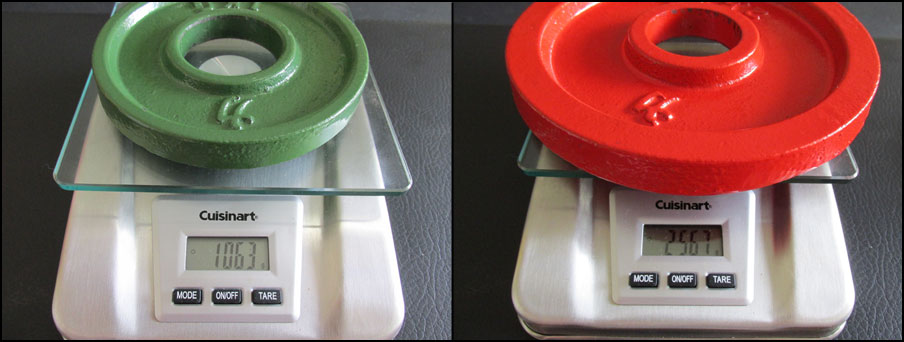
The Strength Shop USA change plates aren’t quite as accurate as the others. Some individual plates were closer than others, but these two were the worst offenders.
I appreciate that someone offers steel kilogram change plates at a slightly better price than rubber-coated, but again, over the years the price has climbed and they are just too pricey considering their inaccuracy and what they do to nice Olympic bars.
Rogue Kilogram Change Plates
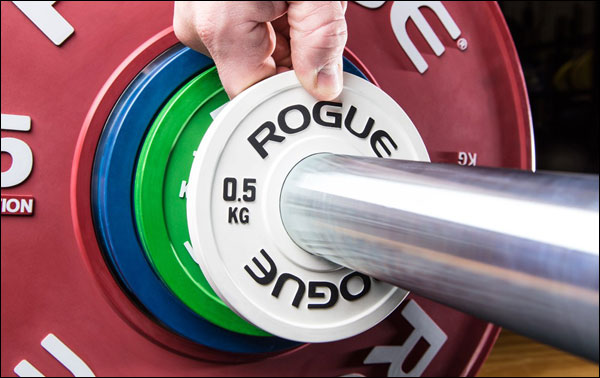
The Rogue kilogram change plates are literally the same plate as the Eleiko change plates, only without the IWF-certification. These are the perfect alternative to Eleiko if you want this style.
In any case, Rogue’s change plates are metal at their core, but they are covered in a thin rubber coating. This rubber not only helps protect the plates from getting dinged up when they smash into each other on the bar, but it also helps to protect your sleeves from getting dinged up as well. Better yet, this rubber coating allows you to load up your change plates outside your collars without having to worry about them sliding off; much like friction plates.
Rogue change plates have a matte finish, and the rubber is color coded using the IWF color scheme. The standard six pairs from 0.5 kg to 5 kg are available, and they can be picked up in pairs or sets. Buying the whole set at $265 will get your free shipping.
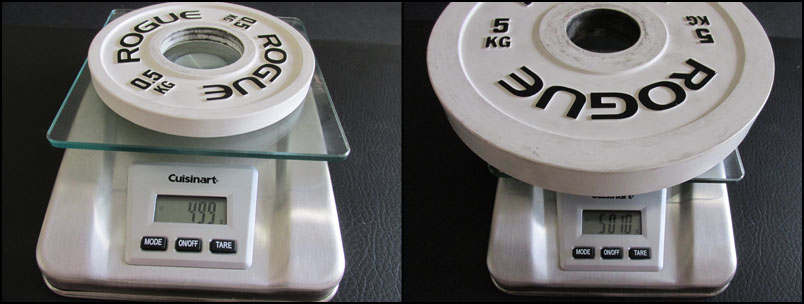
I don’t own the full set of Rogue plates, but the pairs I do have are all within normal weight deviation tolerances. I like the Rogue’s, but they get grungy easily. Everything just seems to stick to them; oils, dirt, etc.
I like Rogue’s plates. I think they’re a great compromise between the too cheap and the too expensive, and between these and the V-Locks they did wonders to help drive change plate prices down. They still cost more than the Vulcan V-Locks, but not by too much – if you’re a Rogue fan and find it’s worth paying the difference.
Eleiko Olympic Comp/Training Kilogram Change Plates
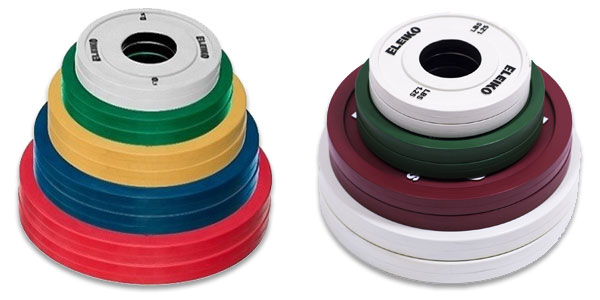
The Eleiko Change Plates are definitely the nicest looking change plates in my collection, but they also happen to be the most expensive. The full 25 kg set consists of all six pairs of IWF-color coded discs (0.5 kg – 5 kg) and sells for $277 before shipping. If you think that’s bad, did you know that they used to sell for $498 prior to Rogue releasing the same plates? That price was just eff’n insane!
There are advantages to owning premium change plates like these. For starters, these are IWF-certified. I realize that most people won’t really care about the certification stamp itself, but by having it you know that your plates can deviate very little from the claimed weight. Also, you technically could bring these to a sanctioned event, where as none of the others on this page are legal equipment.
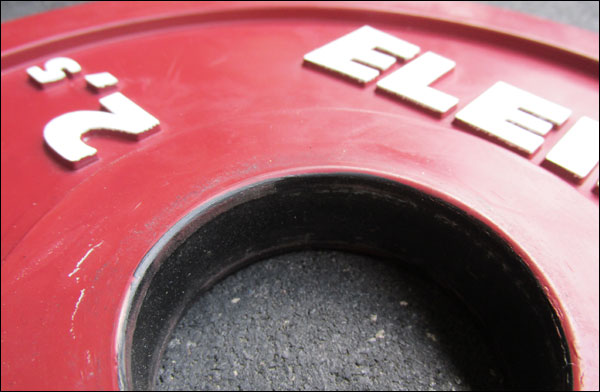
Like the Rogues and Vulcans, the Eleiko set should survive for decades. The coating is well done, and there is actually a thin, protective insert around the circumference of the hole that even the Rogue’s don’t have. The remainder of the rubber coating on the plate feels pretty much the same as the Rogue discs, but that insert will prevent the rubber from flaking away over time as you load and unload the discs on the bar.

These Eleiko Change Plates are within tolerance, but I did expect them to be slightly closer for the price.
Change/Fractional Plates for CrossFit (pounds)
Most CrossFit stores do not carry true kilogram change plates. They usually they only sell iron change plates in pounds (2½-lb, 5-lb, and 10-lb), and the small washer fractional sets in pounds that consist of ¼-lb, ½-lb, ¾-lb, and 1-lb pairs. Fractional plates can be helpful if you do lift in pounds because the change plate options in pounds don’t allow for the minor jumps in weight that kilogram change plates allow for, but you’ll still need the change plates.
Sometimes CrossFit vendors have the same washer-style fractional sets in kilograms, but these are not nearly as helpful as the pound washer sets. Most folks are content with the ½-kg increments that are possible with standard change plates, and don’t need 0.125 or .25 kg jumps. Besides, normal kilogram change plates make three out of four of the included washer plates practically useless (the ½-kg, ¾-kg, and 1-kg.)
Whether you lift in kilograms or pounds, the fact is that fractional plates are useless without also owning change plates, so worry about change plates first.
Vulcan V-Lock in Pounds
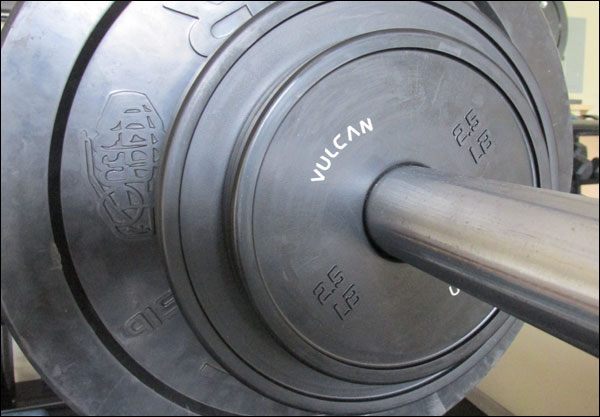
I mentioned that you can run down to the local sporting good stores to pick up those cheap CAP branded cast-iron change plates in 2½ and 5-pound discs. Well, it is an option, but you should know that the super cheap change plates from the box-stores are actually worse for your bar than the SS USA change plates I discussed. Not only is the insert hole so big and uneven that bar damage is unavoidable, but they are embarrassingly inaccurate. You can bring a scale and do you best to avoid the wildly inaccurate plates, or you can again look to V-Locks.
Vulcan recently started offering the V-Lock plates in 2½-pound and 5-pound variants. They are not colored but they are affordable, and like the kilogram V-Locks they contain no iron whatsoever. These are perfect for folks that prefer to work out with pounds rather than kgs, but dislike the metal plates. With these V-Locks, whether you Olympic lift or powerlift, you never have to worry about thrashing your bar during a lift with these rubber plates, and you can rest assured that the claimed weight is accurate.

As with the kilogram V-Locks, the pound version is still an accurate plate. I know that the iron 2½-lb looks pretty damn accurate, but believe me when I say that this particular plate is a fluke. I have over 70-pounds of steel change plates and that particular plate is the closest to its claimed weight by far.
Vulcan sells pairs of 2½-pound V-Locks for $32, and 5-pound V-Lock pairs for $54. You can get all four plates for $75. Just like the kilo V-Locks, the price fairly reasonable.
Rogue Change Plates in Pounds
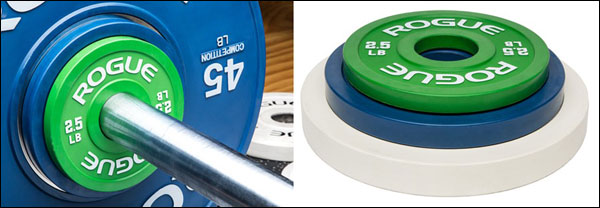
In addition to the kilogram change plates, Rogue offers their rubber coated plates in pounds as well. A full set that includes a pair of 2½’s, 5’s, and 10’s will set you back about $165 and they ship for free. If you don’t need the 10’s because you have those covered by bumpers, a pair of 2½’s and 5’s will cost you about $75, but without shipping included. The colors are pretty cool, but in this case the V-Locks aren’t really any more affordable, making it a wash.
Honorable Mention – Rogue Calibrated Powerlifting Plates

Guaranteed to be accurate to within 10 grams, the Rogue Calibrated Steel Plates feature various change plate sizes. These plates are quite pricey, and they are steel, but they are accurate.
For pounds there are 0.25 lb, 0.5 lb, 1 lb, 2.5 lb, and 5 lb change plates available (sold in pairs).
For kilograms there are 0.25 kg, 0.5 kg, 1.25 kg, 2.5 kg, and 5 kg plates available (sold in pairs).
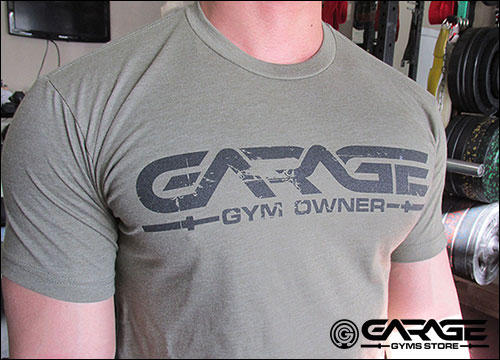

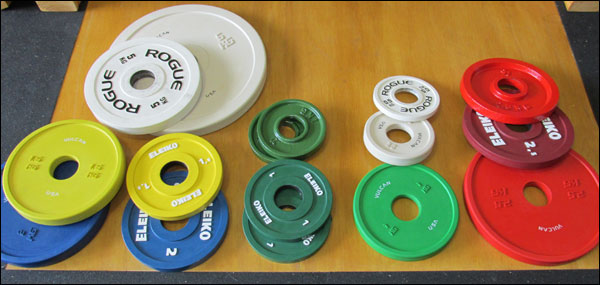
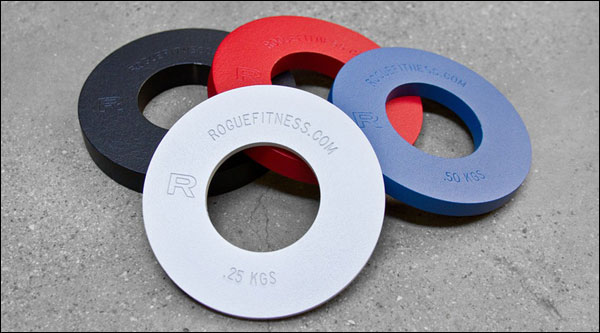
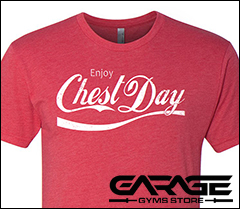
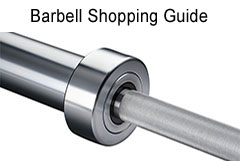
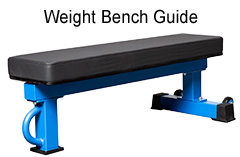
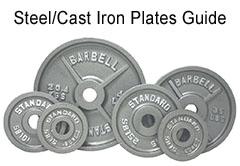
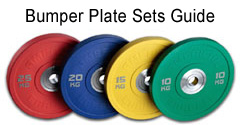
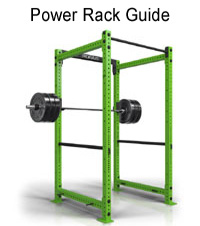
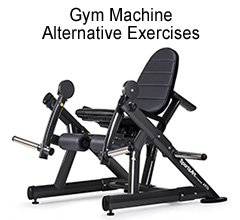

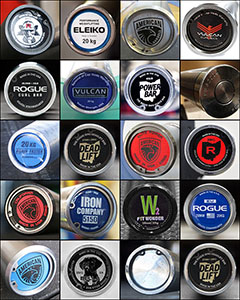

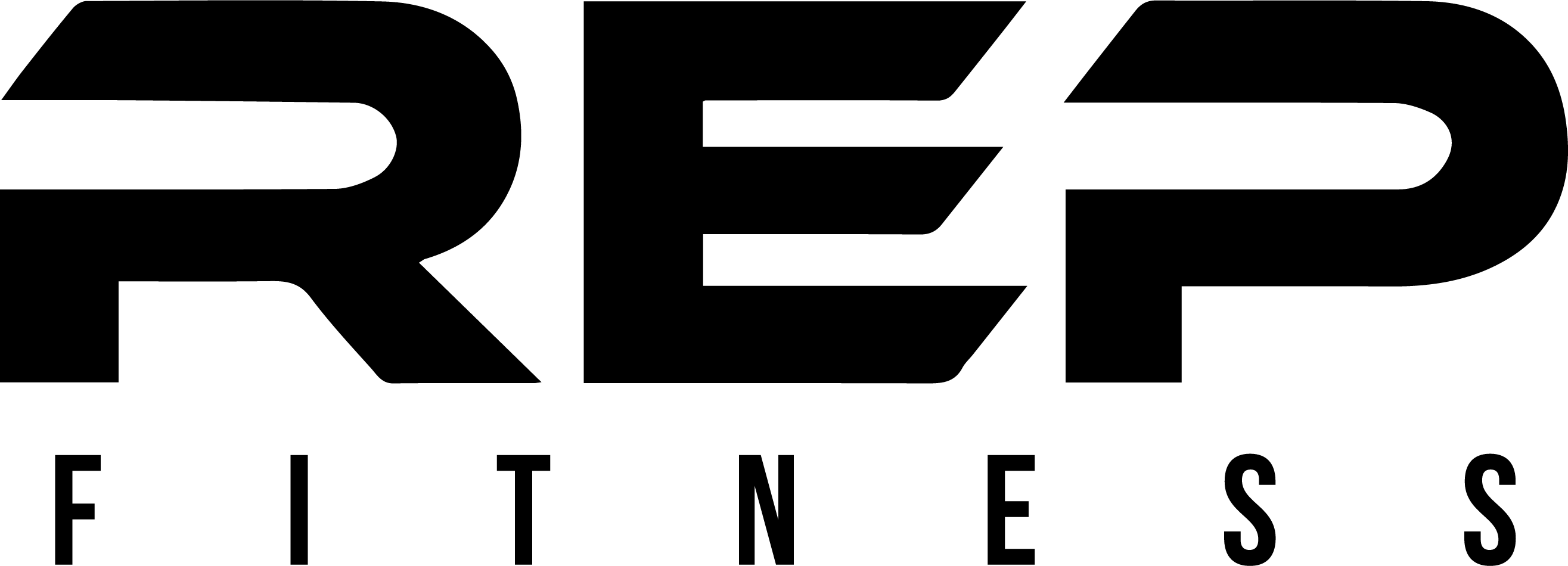
No review of the Pendlay rubber change plates……..they are awesome(most sarcastic available!!)
Ironically, I’ve tried to convince friends to buy decent change plates and you hit it here. solid metal, or painted metal will damage your bar and it will piss you off. I had a set of old metal change plates and it gauged the sleeve of my old DHS bar and I was pissed. Does the size of the Vulcan plates not annoy you? they just look odd to me.
haha the review for the SSUSA plates apply to the Pendlay as well… they no longer have rubber I don’t think. Those too were problem plates for their own reasons, but I assume you know that haha.
No the size doesn’t bother me. I can’t see them when I’m lifting anyway =p They do look weird at first though, but man for the money and no worries of metal ever coming through, I don’t care what they look like. Plus they’re surprisingly accurate. I dig the Eleiko’s, but they cost just way too much. They aren’t much different than Rogue’s at all, not 100% more money different that’s for sure.
My first changes where those bad ones. Just fell apart, absolute crap!! I’ve got a set of Eleikos given to me, but I really like the WerkSan Frictions.
I’m very curious to learn who makes rogues newest comp plates and change plates, because they spec out and look just like the Eleiko’s.
They sure do. They won’t tell us though.
I can save you the suspense…lol they are made by a Chinese company called Quanzhou LianXin Silicone Rubber Product Co., Ltd.
They are available through them branded as “Villain Fitness” and are $9 for a 5 pound, $7 for a 2.5 lb. All KG plates are also available at a low of $4.80 for the 0.5kg to $9 for the 2.5kg
Cheers
It is strange that the KG plate sets come with 5 or 6 pairs, while the LB plate sets come with only 2 or 3 pairs. I guess Vulcan is assuming that if you are buying their change plates that you have 10 and 15 lb black plates. But how does Rogue expect you to bridge the gap to their smallest comp plate which is 25 pounds? Buy an extra pair of 5’s or 10’s?
Yeah you’re right, I think Vulcan is assuming that you already own 10 and 15 pound bumper plates in a basic set, or at least two pairs of 10’s.
In regards to comp plates, with kilos it’s easier with all 6 plates since it’s simple to go from 0.5 to 10 kilos in half-kilo increments. In pounds, yeah you’d need another pair of 5’s to go from 2.5 to 22.5, and it’s still a total 5-pound jump, so you need fractional plates too if you want to increase weight by less than that 5-pounds. Pounds are just silly like that.
Have you gotten a chance to try the Klokov plates at all?
I didn’t even know those existed! Have they had those long? I’m not their biggest fan but I do visit the site semi-regularly and I don’t remember ever seeing them.
I’ve been eyeballing the Klokov set for a while and they’ve been on there for at least the past couple of months. Got the bar and love it, and I want the plates as well just from an economical standpoint. I just love the look of the places.
https://www.againfaster.com/shop/bumpers-plates/klokov-competition-change-plates-kg-set/
It looks like they didn’t seal off the inside of the hole with rubber completely. That’s metal that you can see in there I think. That’s awful; metal to metal contact between the plates and the bar; no thank you.
All full size plates(that I know of) have some sort of metal hub that is in contact with the bar sleeves. Why is this such a big concern with change plates but not full size plates?
I was wondering the same thing.
Oh goodness how to explain this…
full size plates don’t bounce around on the bar when the bar is dropped. Actually, the bar itself bounces around inside the bumpers when it’s dropped. Change plates are free to bounce around on the bar sleeve following a drop. And where the amount of weight on the bar doesn’t really change the impact from the bar’s point of view, the amount of weight on the bar definitely changes the force transferred to the change plates when the bar rebounds on the ground. Does that make sense?
The one sure way to demonstrate this is to simply load up some steel change plates and toss your bar around, then load up some rubber plates and do the same. Also, steel change plates have larger insert openings which allows them more freedom to move around, whereas rubber plates tend to snugly fit around the sleeves.
Point is, steel inserts in bumpers don’t wreck bars. We all know this because we all use bumpers on our bars with no problem. You can help eliminate damage by using steel plates within the collars nice and tight against your bumpers, but that kind of defeats the purpose for most people.
Oh and in all fairness, the steel ring visible on those Klokovs is probably not an issue. However, one of the problems with rubber coated steel plates is that over time that rubber comes off, exposing the steel, which then leads to the plates needing to be replaced. If the steel is always there, isn’t that kind of giving the wear and tear a head start?
Of course, this is all assuming you care. 4/5 people don’t care about the nicks and dings and missing zinc on their bar. I only share all this stuff for the people who own expensive bars and do very much so care about the condition of their bar. It doesn’t matter if you’ve got a Klokov or Ohio, but it matters if you have thousand dollar Eleiko or one of the few SS bars out there.
Hey there, it’s your site’s newest and biggest fan with another question. Forgive my ignorance, but when would you ever not place your change plates or fractionals inside the collars? Maybe that’s an Olympic thing, but if I use a collar, all the weights are going inside the collar. It will be a non-issue now that I have the 2.5# and 5# Vulcans, so that only my 1/4#-1# fractionals could rattle around, but they’ll be inside the collar. I just want to make sure I don’t screw up the Eleiko or AB SS once I get them!
It also appears that AB is making a urethane set of pound fractionals for a great price, at least cheaper than Rogue’s. Thoughts?
http://americanbarbell.com/products/american-barbell-urethane-fractional-bumper-plates-lbs
I don’t think they weigh enough to hurt the bar. I tend to clip everything behind the collars just because it’s just me on the bar and I don’t really mind having to fiddle with the collar to change weights. The idea of quickly changing plates is more about multiple people using the same bar, like in a WL gym or on stage. But still, those fractional probably don’t matter I don’t think. Of course if it makes you feel any better, you could use rubber/urethane like the ABs you linked.
btw, you always get stuck in the spam filter because you put a link to the page your on in the ‘website’ field. Leave that field blank and your comments “shouldn’t” get sent to moderation.
I just found American Barbell also have the Urethane Fractional Plates with Kilo and LB version, which looks pretty good. do you think they are better than the rubber ones?
I haven’t seen those AB plates yet. I know AB likes working with urethane, but I don’t know if there is actually any advantage to doing so, especially in the case of change plates.
Any feedback on the Rally fitness. Seemed pretty good for a set of 2.5 & 5 for ~ $33. Or, are these just the cheaper steel ones?
I hadn’t seen those before. They look fine since they’ve still got a rubber coating and the insert is a solid, smooth piece… no sharp edges like you find on cast iron plates. They look almost like an economy version of commercial rubber coated plates. Price is reasonable.
I got the Rogue change plates in lbs. It came with the 2.5 and 5 lbs plates. They all weighed within 1/8 oz of each designated weight and like you suspected they fit the bar snugly.
I’ve been waiting for the v-locks in pounds to come back in stock but a plateau in one of my lifts is making me start to consider other options instead of waiting.
The Rogues seem like the obvious next choice, but are more expensive and also aren’t pure rubber but metal plates with rubber coating. The main question I have for you or anyone that has the rogues is has the rubber ever worn down to the metal in the center? I know you mention that the rubber can wear down to the metal eventually, but how long would that actually take?
Thanks again for another great article.
I still use my Rogue change plates nearly daily, and I’ve not had any issues. They get super dirty, but they are staying together just fine. Feedback is great on both, so if you’re tired of waiting around, stop waiting =p
Do you use the Vulcan V-Locks with your American Barbell SS bars? The Vulcan website lists the center opening as 50.2 mm, and I recall your caliper measurements on the American Barbell double chrome sleeve to be 50.1 mm. Seems really tight, and I’m curious if they are a hassle to use.
Thanks for all of the great content and reviews.
Heya, ya the V-locks work fine on the SS bars including the Pro; which is the only one I’ve actually measured for that thickness now that I think about it. It’s not even especially tight, but the fact that the sleeves aren’t ribbed means it’s no problem whatsoever to get them on and off. Keeps the bar looking nice too, I dig those V-locks.
Looking at the hi temp 5 lb plates…found on xtrainingequipment.com $29 for a pair and free shipping + offered $5 off for signing up for mailing list. Should I wait for the 5 lb Vulcan vlocks ? I still want to buy the Vulcan 2.5s but in a dilemma over what 5 lb plates to buy. Does a full size bumper have any advantage over a smaller change plate? Thanks in advance!
For a change plate I don’t think it matters. The HI-temp is huge for a 5 lb plate, but if that appeals to you for some reason there is nothing wrong with it, but I wouldn’t say that there is a benefit to them being large. I’d buy both the 5’s and 2.5s as V-locks, but they always out of stock so if you need them now, may have to do something else.
Any thoughts on the EquipmentRaw gear? They have change plates (they call them fractional plates) that are rubber and quite inexpensive.
They look like copycats of the Vulcan rubber change. Probably the same thing. Don’t know anything about this company though, just basing that on the picture.
I lift in pounds (maybe my first problem), and hate dealing with 10lbs bumper plates. I’m looking to protect my sleeve, while keeping noise down, and the only 10lbs rubber change plate seems to be made by Rogue. I’ve got a pair of Vulcan 5’s and 2.5’s and the all rubber calibrated micro plates from CFF (btw, I weighted them all and they were all exactly the stated weight). I love that these can stay outside the collar for quick changes, make little noise when dropped, are all spot on in weight, and don’t damage the bar. I just cannot find comparable plates in 10lbs. Do you know of any? Someone above mentioned Rally Fitness. They have rubber coated 10lbs plates with rounded steal inserts at a fair price. Do you think those would fit the bill as far as keeping bar damage and noise down? I realize these small plates bounce around on the bar v. the bar bouncing inside the 450mm plates.
Yeah they aren’t bumpers, but since they are smaller diameter being used with your bumpers, I don’t see how they couldn’t help with noise. The steel insert won’t damage your sleeves any more than a normal bumper would, so that’s not a problem either. Steel plates are so bad for bar sleeves because the holes are too big, and the edges aren’t rounded. Those Rally plates should be fine and dandy. Oh also, the Vulcan Alpha 10-pound is 400 mm versus 450 mm.
Thanks! I’ve got a mix of OFW’s and AF crumb rubbers (the OFW 10’s are smaller in diameter, but not anything close to the Vulcan’s). The Vulcan Alpha plates are some great looking plates and if I had to do it all over again from scratch, they’d be high in the running. Was it you who said they’re similar in sound reduction to the Elieko XF’s (and without the problem in the collar)? But I digress, the Vulcan 10lbs pairs fit my bill to a tee, but they’re almost as expensive as the Rogue change plates, so I’ll be going with generic rubber coated steel inserted 10lbs. As so many others have said: great site. My only suggestion is if you did updates to older reviews as you gain more experience with items and/or new items expose older item’s flaws.
I actually want to do an article like that – something like a “where is it now?” type thing where i go through old reviews and update on the products condition and all that. And ya that was me regarding the ALphas and Eleikos. =)
Im considering these to go with the 10kg-25kg rogue calibrated kg steel plates. http://www.lynxbarbell.com/collections/bumper-plates/products/kg-change-plates
Yeah those are like the SS-USA plates. Definitely not as premium of a plate, but a hell of a lot cheaper!
Am I mistaken or does a 25kg set of Vulcan change plates cost $330.34 now?
I see $239 on the site. Are you seeing this price through a re-seller? Perhaps a Canadian or European re-seller?
Another great guide/review! For the price of the Eleiko’s you’d want them to be perfectly accurate to their weight. I would not accept anything less for that price
If not mounting outside the collar, are there any benefits to friction grip plates?
Do they have a better insert less likely to cause wear and tear on the bar?
No there is not. I wouldn’t buy friction plates in that situation.
They have a tight-fitting rubber insert rather than a metal insert. Sure it’s better for the bar, but you don’t have to buy friction plates to get a rubber insert.
Do you have an article on dumbbell change plates? I’m looking at rouges but they dont have 2.5 plates which is what I want since my dumbbells from 60-100 IB are increments of 10. It doesn’t look like there are enough room on the dumbbell to add 1.5 & 1 pound plate to it and still have room to grip. Any suggestions or previous articles is appreciated. thanks
update I found these Micro Gainz Banded 2.5LB Pair of Dumbbell Fractional Weight Plates for Dumbbell Training and I think I’m going to give them a try.